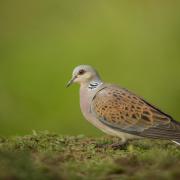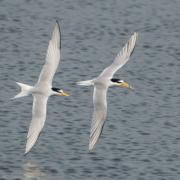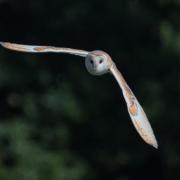Cormorants have made a home in Suffolk’s watery landscape. Ross Bentley has been following the success of this remarkable, almost prehistoric water bird
Wherever you look, wildlife is under threat from human activity and many animal species are experiencing deeply concerning declines in numbers. There are, however, a few exceptions. One is the cormorant. A bird at home on the water, an expert diver and fisher, the UK's cormorant population has exploded in numbers in recent decades - and East Anglia is at the centre of this success story.
The name cormorant is derived from the Latin corvus marinus, which translates as ‘sea raven’ due to its size and dark feathers. Cormorants are associated with the sea but they are also found in other watery habitats. Britain’s native cormorant is mostly confined to the coastal rocks of western Britain but its continental cousin prefers to roost in trees, building nests of seaweed, reed and twigs. It is this sub-species that has spread from Europe - thanks to protective legislation against persecution – and can now be seen in high numbers on the east coast and increasingly on the region's estuaries and inland waterways.
The first cormorants to breed inland in the UK did so in 1981, when a tree-nesting colony became established at Abberton Reservoir near Colchester, just over the Suffolk border in Essex. It was not until 1998 that the first cormorants bred in Suffolk at Trimley Marshes, on the River Orwell near Felixstowe. From our small corner of the island, these cormorants have since spread out in the past 20 or so years and are now widely distributed at inland sites across Britain.

“It’s a remarkable upturn in fortune for the cormorant in the east, and another example of how nature is always changing,” says John Grant, president of the Suffolk Bird Group, who reports that colonies of 3,000 cormorants have been recorded at several locations along the county’s coastline.
Inland waterways
My experience of cormorants is in far fewer numbers at inland locations in west Suffolk. I regularly see them flying over Sudbury’s Common Lands, their short wings powering them like black darts, non-stop towards their next watery destination.
At Suffolk Wildlife Trust’s Lackford Lakes reserve near Bury St Edmunds, I recently studied a group of around 10 cormorants, some resting on an artificial island in the middle of the lake, another group gathered on low-hanging willow branches on the edge of the far side. It is common to see cormorants nestled together on dead or dying branches. According to the British Trust for Ornithology, one of the side-effects of cormorants nesting together as a colony is that the volume of droppings kills the trees over time.
Dive, dive!
As I watched, every now and then a cormorant would fly fast over the water’s surface, like a miniature seaplane. Once in the water, they swim incredibly low, the water almost washing across their back. They resemble a submarine about to resurface, their long neck and large beak with a hook on the end playing the part of a sinister periscope.

They certainly submerge like submarines - no nonsense, just point the beak down and the sleek body follows. Some of the world's cormorant species have been known to dive as deep 150 metres. I doubt these went anywhere near that depth but some stayed under for an impressive 30 seconds or so – reappearing some distance from where they had taken the plunge.
Research has shown that the cormorant’s ears and eyes are adapted for prolonged periods underwater although it is believed that the bird does not see with much more clarity that humans below the surface. Instead, they rely on swimming fast and far in the hope of coming across prey that can be grabbed at close quarters.
Expert fishers
Cormorants’ ability to catch fish is well-known. Fishermen in Asia have used the birds for centuries, tethering them around the neck so that any fish they catch does not get swallowed and can be retrieved. King James I of England also had a coterie of cormorants for sports fishing. The bird will tackle fish of all sizes, even large pike, and has an incredible ability to open its throat to gulp them down whole.


You would have thought that anglers would admire the skill and expertise of the cormorant but the birds have been demonised by them. Owners of commercial fisheries complain they are threatening their businesses and some locations in Suffolk have been issued licences to cull cormorants.
Ironically, it is these very fisheries that are partly responsible for the cormorants' breeding success in recent years which has brought them into conflict with humans. Stocked with fish that are easy to catch, the fisheries are effectively a watery version of the back garden bird table.
The eyes have it
The cormorant is not what you would call a classically attractive bird. When it stands with its wings outstretched there is something prehistoric about it, and this modern-day pterosaur has very little colour. Our cormorants are mostly black, sometimes with white patches on the belly and sides, and a small flash of yellow on the jowls showing the way to its lethal beak. But it is the eye of a cormorant that catches the breath – a stunningly fierce and staring turquoise jewel placed within a mass of black feathers.

It is because the cormorant is mostly black that it has been connected with evil down the ages. For example, in the famous 17th century poem Paradise Lost, author John Milton portrays Satan himself breaking into Paradise and sitting on the Tree of Life “like a cormorant”...
However, in some quarters the cormorant is considered a good omen. In Norwegian tradition, for instance, spirits of those lost at sea come to visit their loved ones disguised as cormorants.
What about those wings?
Cormorants are renowned for their classic ‘crucifix’ posture, where they hold their wings outstretched on each side. From a distance, their dark form resembles a giant bat and the effect is amplified if they are striking the pose in a tree. But what is behind this strange habit?

Research has shown that the microscopic structure of cormorant’s wings means they get wetter than many other species of water bird. But far from being a disadvantage, this tendency towards sogginess makes the bird less buoyant and better suited to diving deep and staying underwater. But they need to dry their wings in between dips.
There are many theories as to the additional benefits of spreading the wings in this way. Some say it enables cormorants to warm up quicker once out of the water, as their black feathers soak up the sun’s rays. Others posit that the stance – standing upright with wings back, chest puffed out – helps cormorants digest their food better.
So, the next time you feel a bit of indigestion coming on, you know what to do...



























